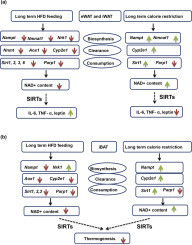The Journal of Nutritional Biochemistry ( IF 5.6 ) Pub Date : 2020-03-19 , DOI: 10.1016/j.jnutbio.2020.108377 Xiaojing Wei 1 , Ru Jia 2 , Guan Wang 3 , Shangyu Hong 4 , Lin Song 1 , Bo Sun 1 , Ke Chen 1 , Nan Wang 1 , Qiqi Wang 1 , Xiao Luo 1 , Jianqun Yan 1

|
Deteriorated nicotinamide adenine dinucleotide (NAD+)/sirtuins (SIRTs) metabolism in adipose tissue is implicated in diet-induced obesity, while calorie restriction (CR)-induced beneficial effects require sufficient NAD+ biosynthesis. Mechanistic links have not been defined. This study aims to identify changes of specific components of NAD+/SIRTs system in white adipose tissue (WAT) and brown adipose tissue (BAT) of mice upon energy imbalance, focusing on key enzymes in NAD+ salvage (Nampt, Nmnat1, Nrk1), clearance (Nnmt, Aox1, Cyp2e1) and consumption pathways (Sirt1, Sirt2, Sirt3, Sirt6, Parp1). Male C57BL/6J mice were fed ad libitum with the standard laboratory chow diet, high-fat diet (HFD) or 40% CR diet, respectively. The epididymal and inguinal WAT (eWAT and iWAT) and interscapular BAT (iBAT) were harvested for histological, NAD+ assay, gene and protein expression analysis after 16 weeks of dietary regimen. HFD decreased, while CR increased, the NAD+ and NADH levels in eWAT, iWAT and iBAT. NAD+ content negatively correlated with plasma cholesterol, TNF-α levels and calorie intake, while it positively correlated with plasma adiponectin level. The change trend of SIRT1 is quite the same as that of NAD+/NADH ratio. Nmnat1 gene is sensitive to energy imbalance in WAT but not in BAT. Nrk1 gene expression was decreased in eWAT and iWAT but increased in iBAT of HFD mice. Nnmt mRNA and protein abundance was increased in iWAT of HFD mice. Nampt, Cyp2e1 and Sirt3 were the most robust genes responding to energy imbalance. In summary, adipose tissue responds to long-term energy excess or shortage with depot-specific transcriptional activation or repression of NAD+/SIRTs metabolic components.
中文翻译:

响应高脂饮食喂养或热量限制,在小鼠脂肪组织中鉴定到的NAD + / SIRTs代谢的仓库特定调节。
饮食组织中肥胖引起的烟酰胺腺嘌呤二核苷酸(NAD +)/ sirtuins(SIRTs)代谢恶化与饮食诱导的肥胖有关,而卡路里限制(CR)诱导的有益作用需要充分的NAD +生物合成。机械链接尚未定义。这项研究旨在确定能量平衡失调的小鼠白色脂肪组织(WAT)和棕色脂肪组织(BAT)中NAD + / SIRTs系统特定成分的变化,重点研究NAD +清除中的关键酶(Nampt,Nmnat1,Nrk1) ,清除(Nnmt,Aox1,Cyp2e1)和消耗途径(Sirt1,Sirt2,Sirt3,Sirt6,Parp1)。随意给雄性C57BL / 6J小鼠喂食标准实验室食物,高脂饮食(HFD)或40%CR饮食。饮食方案16周后,收集附睾和腹股沟WAT(eWAT和iWAT)和肩inter间BAT(iBAT)用于组织学,NAD +测定,基因和蛋白质表达分析。HFD降低,而CR增加,eWAT,iWAT和iBAT中的NAD +和NADH水平。NAD +含量与血浆胆固醇,TNF-α水平和卡路里摄入量呈负相关,而与血浆脂联素水平呈正相关。SIRT1的变化趋势与NAD + / NADH比的变化趋势完全相同。Nmnat1基因对WAT中的能量失衡敏感,而对BAT中不敏感。Nrk1基因表达在eWAT和iWAT中降低,但在HFD小鼠的iBAT中升高。HFD小鼠的iWAT中Nnmt mRNA和蛋白质丰度增加。Nampt,Cyp2e1和Sirt3是对能量失衡最有力的基因。总之,脂肪组织对长时能量过剩或不足的反应是仓库特异性的转录激活或NAD + / SIRTs代谢成分的阻遏。



























 京公网安备 11010802027423号
京公网安备 11010802027423号